Rochester is a foodie town, and with legal recreational cannabis coming to New York, the availability of commercially-produced cannabis edibles is poised to explode.
But those who love to cook may want to experiment with cannabis as an ingredient in their own kitchen. One of the easiest and most efficient ways to consume cannabis is through homemade cannabutter.
As the name implies, cannabutter is a combination of cannabis and butter and it provides an opportunity for us to explore a more refined use of the flower. What’s great about cannabutter is its versatility. It can be used in any recipe that calls for butter, like baked goods such as cookies and brownies, but it can also be spread on a morning muffin or a dinner roll, or melted over a side of vegetables, like asparagus, broccoli, and mashed potatoes.
But wait, there’s more! The same principles used to make cannabutter can be applied to make THC-infused olive oil, coconut oil, or any other fatty cooking mediums.
What follows is a three-step process for making cannabutter (THC-infused, clarified butter), as well as three recipes to try with your creation. Not in the mood for an elevated evening? Each of the recipes can be enjoyed without the THC.
Note: It is crucial to remember that homemade edibles are notoriously difficult to accurately dose. There’s just no good way to gauge the potency or amount of THC in any DIY infusions. Use responsibly.
CLARIFIED CANNABUTTER
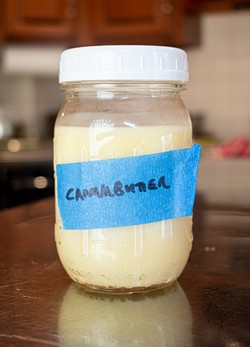 This formula has a one-to-one ratio of butter to ground, dried cannabis and can be expanded or reduced in size while keeping the 1:1 ratio. For this example, we are using 1 cup of clarified butter to 1 cup of ground, dried cannabis, which works out to between 7 and 10 grams.
This formula has a one-to-one ratio of butter to ground, dried cannabis and can be expanded or reduced in size while keeping the 1:1 ratio. For this example, we are using 1 cup of clarified butter to 1 cup of ground, dried cannabis, which works out to between 7 and 10 grams.
Step 1: Prepare the cannabis
Before you can make cannabutter, your cannabis needs to decarboxylate, or “decarb.” This heating process converts the plant’s non-intoxicating acidic cannabinoid called THCA into THC, the molecule that delivers the euphoric effect you want. The same process takes place when the plant is smoked or vaporized.
Skipping this process will result in weaker or downright ineffective THC levels.
There are a variety of ways to apply heat to cannabis for decarbing, but the best way is in the oven. Preheat your oven to 235 degrees Fahrenheit. Evenly spread out the cannabis on an oven-safe tray lined with parchment paper. Place the tray on a center rack and bake for 25-35 minutes.
Cooking times will vary based on the oven and moisture content of the cannabis. Ideally you want the final product to have reached a sustained temperature of 230-240 degrees, and for the cannabis to appear lightly toasted.
Step 2: Clarify the butter
Clarifying the butter — meaning extracting water and solid milk proteins — before infusing it with cannabis will give your cannabutter a more stable, versatile, and higher-quality end result. THC-infused clarified butter can last for months in the refrigerator.
The yield of store-bought butter to clarified butter is about half of the original amount, so to produce 1 cup of clarified butter you need to start with 2 cups (4 sticks) of unsalted butter.
Note: This process can be streamlined by buying ghee and skipping directly to step 3.
Start by cutting the butter into cubes, and placing them in a small saucepan. Melt the butter on the stovetop over medium heat.
Continue gently cooking over medium to medium-high heat until a layer of white milk protein begins to separate to the surface. Increase heat to high and bring to a low boil until the proteins begin to froth.
Lower the heat back to medium and continue to gently simmer until the milk proteins continue to separate and sink to the bottom of the pan. Adjust the heat as needed and continue to gently simmer and boil off any remaining water content, without scorching the milk proteins at the bottom of the pan.
Once the water content has boiled off and the fat and proteins have separated, gently strain the butter through a cheesecloth into a heat-resistant jar using a funnel and allow to cool before refrigerating.
Clarified butter can last refrigerated for up to 6 months.
Step 3: Infusion
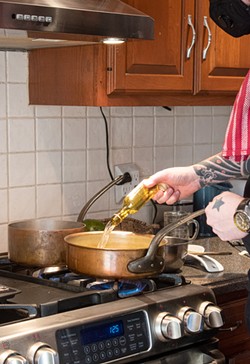 Once you’ve clarified roughly 1 cup of butter, it is time to infuse it with the prepared cannabis. Basically, you are treating this step of the process the same way you would brew tea, only for a much longer amount of time.
Once you’ve clarified roughly 1 cup of butter, it is time to infuse it with the prepared cannabis. Basically, you are treating this step of the process the same way you would brew tea, only for a much longer amount of time.
On the stovetop using low heat, bring the clarified butter to a very low simmer, ideally between 160-180 degrees (never higher than 200 degrees). Add in the previously prepared cannabis, mix well, and let gently simmer for two-and-a-half hours, stirring every half hour.
Remove from heat and let sit for an additional 10-15 minutes before straining. Strain the butter through a cheese cloth into a heat -resistant jar using a funnel and allow time for the butter to drip through without squeezing the cheese cloth. Be patient. Ringing or squeezing the cheese cloth will dramatically alter the flavor of the final infused butter.
Chill the butter overnight. This same infusion process can be applied to olive oil, coconut oil, or any number of other fatty cooking mediums.
ELEVATED APPLICATIONS
Now that you have a supply of THC-infused cannabutter, it’s time to use it in some culinary endeavors.
The three examples presented here include an appetizer, a main dish, and an exotic dessert. But the real possibilities are endless.
Just keep in mind that the potency of your cannabutter will vary, so it’s best to use it sparingly.
Appetizer: Roasted garlic butter bruschetta canapés
Serves 2-4
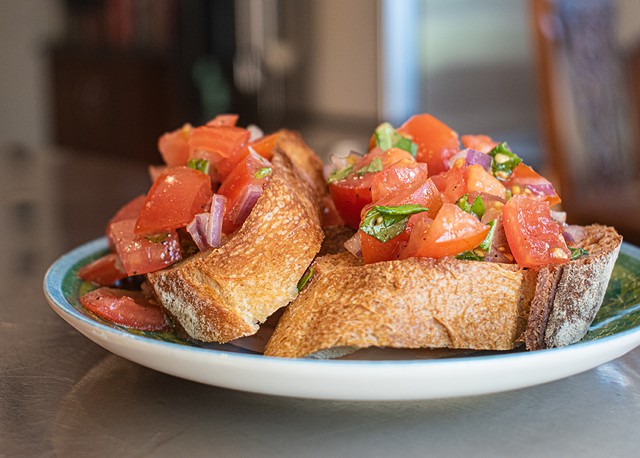 You will need:
You will need:
1 baguette (thinly sliced on the bias)
2-3 Roma tomatoes (medium diced)
1/2 small red onion (finely diced)
3-5 tablespoons fresh basil (roughly chopped)
3-4 tablespoons olive oil
5-6 large garlic cloves (roasted and mashed)
2-3 tablespoons cannabutter (room temperature)
Salt and pepper to taste
Instructions:
1. Mix the diced tomato, onion, basil, and olive oil in a non-reactive bowl, adding salt and pepper to taste. Let the mixture stand at room temperature for 30-40 minutes to marry the flavors.
2. In a separate bowl, mix the roasted garlic and the cannabutter into a thick paste.
3. Preheat the oven to 350 degrees. Arrange the sliced baguette on a non-stick oven-safe tray. Using the back of a spoon, smear a small amount of the garlic butter mixture on the top of each baguette slice. Place the tray on the center rack of the oven and bake until evenly toasted (about 10 minutes).
4. Remove from the oven and allow the baguettes to cool enough to be comfortably handled and top each slice with two tablespoons of the tomato basil mixture. Serve warm.
Main Dish: Creamy butter & mushroom risotto with white wine
Serves 2-4
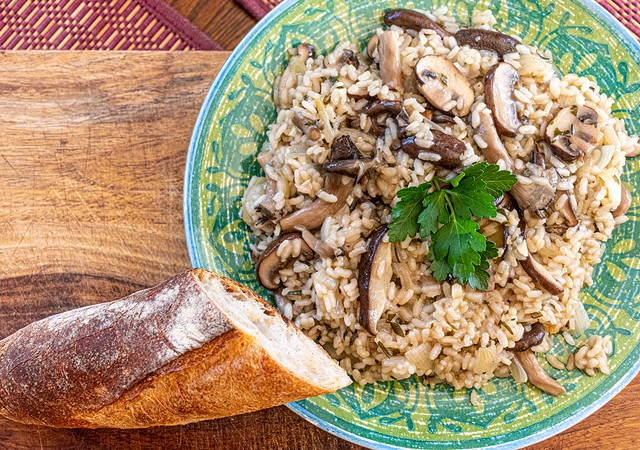 You will need:
You will need:
8-10 cups chicken or vegetable stock
3 cups arborio rice
1 cup white wine
1 lb. assorted mushrooms (thinly sliced)
1 small yellow onion (finely diced)
4-6 cloves fresh garlic (roughly chopped)
1/4 cup olive oil
1/4 cup fresh parsley (roughly chopped)
1 tablespoon fresh thyme (removed from stems)
1 tablespoon fresh rosemary (finely chopped)
2-3 tablespoons unsalted butter
2-3 tablespoons cannabutter
Salt and pepper to taste
Instructions:
1. In a large saucepan, bring the stock to a simmer over medium-high heat, then reduce to low heat to keep the stock perpetually warm throughout the cooking process.
2. In a separate large sauce or flat-bottomed sauté pan, heat the olive oil over medium to medium-high heat until it begins to lightly smoke. Add in the garlic and onion, cook until softened (about five minutes). Add in the dry rice, mix well, then cover the mixture with the white wine and bring to a simmer. Allow the wine to reduce until the mixture has thickened. Add in the thyme, rosemary, parsley, mushrooms, and salt and pepper to taste, mix well.
3. Begin ladling the stock over the rice, just enough to cover the rice mixture with each interval as the rice absorbs the stock, stirring frequently. Repeat this process until the rice is fully cooked al dente (soft outside, slightly firm inside) and the mixture still retains a soupy (not firm) consistency (roughly one hour). Add in the butter and allow to melt, stir completely, and serve warm.
Dessert: Moroccan fruit salad with mint
Serves 4-6
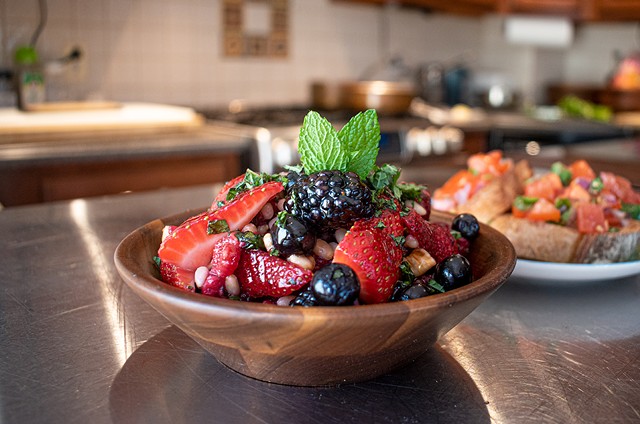 You will need:
You will need:
1/2 cup strawberries (stems removed, cut into quarters)
1/2 cup fresh or dried figs (stems removed, cut into quarters)
1/4 cup fresh blueberries
1/4 cup fresh blackberries
1/4 cup fresh raspberries
1/4 cup toasted pine nuts
4-5 tablespoons fresh mint leaves (finely chopped)
6-8 tablespoons buckwheat honey
2-3 tablespoons cannabutter (room temperature)
Instructions:
1. Starting at room temperature, thoroughly wash and dry the figs and berries. In a non-reactive bowl gently toss the figs, berries, pine nuts, and cannabutter with half of the fresh mint leaves.
2. Separate into individual portions and place the mixture into serving bowls. Generously drizzle honey over each serving and garnish with the remaining mint leaves. Serve at room temperature.
J. Nevadomski is the author of the long-running "Highlife for Lowlifes" series (2013-present) and is a food and culture contributor to CITY. For more visit: highlifeforlowlifes.com, instagram.com/jnevadomski, and facebook.com/highlifeforlowlifes.
Feedback on this article can be directed to Rebecca Rafferty, CITY's life editor, at [email protected].
But those who love to cook may want to experiment with cannabis as an ingredient in their own kitchen. One of the easiest and most efficient ways to consume cannabis is through homemade cannabutter.
As the name implies, cannabutter is a combination of cannabis and butter and it provides an opportunity for us to explore a more refined use of the flower. What’s great about cannabutter is its versatility. It can be used in any recipe that calls for butter, like baked goods such as cookies and brownies, but it can also be spread on a morning muffin or a dinner roll, or melted over a side of vegetables, like asparagus, broccoli, and mashed potatoes.
But wait, there’s more! The same principles used to make cannabutter can be applied to make THC-infused olive oil, coconut oil, or any other fatty cooking mediums.
What follows is a three-step process for making cannabutter (THC-infused, clarified butter), as well as three recipes to try with your creation. Not in the mood for an elevated evening? Each of the recipes can be enjoyed without the THC.
Note: It is crucial to remember that homemade edibles are notoriously difficult to accurately dose. There’s just no good way to gauge the potency or amount of THC in any DIY infusions. Use responsibly.
CLARIFIED CANNABUTTER

- PHOTO BY JACOB WALSH
- This easy-to-make clarified cannabutter can be used in any recipe that calls for butter.
Step 1: Prepare the cannabis
Before you can make cannabutter, your cannabis needs to decarboxylate, or “decarb.” This heating process converts the plant’s non-intoxicating acidic cannabinoid called THCA into THC, the molecule that delivers the euphoric effect you want. The same process takes place when the plant is smoked or vaporized.
Skipping this process will result in weaker or downright ineffective THC levels.
There are a variety of ways to apply heat to cannabis for decarbing, but the best way is in the oven. Preheat your oven to 235 degrees Fahrenheit. Evenly spread out the cannabis on an oven-safe tray lined with parchment paper. Place the tray on a center rack and bake for 25-35 minutes.
Cooking times will vary based on the oven and moisture content of the cannabis. Ideally you want the final product to have reached a sustained temperature of 230-240 degrees, and for the cannabis to appear lightly toasted.
Step 2: Clarify the butter
Clarifying the butter — meaning extracting water and solid milk proteins — before infusing it with cannabis will give your cannabutter a more stable, versatile, and higher-quality end result. THC-infused clarified butter can last for months in the refrigerator.
The yield of store-bought butter to clarified butter is about half of the original amount, so to produce 1 cup of clarified butter you need to start with 2 cups (4 sticks) of unsalted butter.
Note: This process can be streamlined by buying ghee and skipping directly to step 3.
Start by cutting the butter into cubes, and placing them in a small saucepan. Melt the butter on the stovetop over medium heat.
Continue gently cooking over medium to medium-high heat until a layer of white milk protein begins to separate to the surface. Increase heat to high and bring to a low boil until the proteins begin to froth.
Lower the heat back to medium and continue to gently simmer until the milk proteins continue to separate and sink to the bottom of the pan. Adjust the heat as needed and continue to gently simmer and boil off any remaining water content, without scorching the milk proteins at the bottom of the pan.
Once the water content has boiled off and the fat and proteins have separated, gently strain the butter through a cheesecloth into a heat-resistant jar using a funnel and allow to cool before refrigerating.
Clarified butter can last refrigerated for up to 6 months.
Step 3: Infusion

- PHOTO BY JACOB WALSH
- Not a big fan of butter? You can infuse olive oil, coconut oil, or any other fatty cooking liquid with THC.
On the stovetop using low heat, bring the clarified butter to a very low simmer, ideally between 160-180 degrees (never higher than 200 degrees). Add in the previously prepared cannabis, mix well, and let gently simmer for two-and-a-half hours, stirring every half hour.
Remove from heat and let sit for an additional 10-15 minutes before straining. Strain the butter through a cheese cloth into a heat -resistant jar using a funnel and allow time for the butter to drip through without squeezing the cheese cloth. Be patient. Ringing or squeezing the cheese cloth will dramatically alter the flavor of the final infused butter.
Chill the butter overnight. This same infusion process can be applied to olive oil, coconut oil, or any number of other fatty cooking mediums.
ELEVATED APPLICATIONS
Now that you have a supply of THC-infused cannabutter, it’s time to use it in some culinary endeavors.
The three examples presented here include an appetizer, a main dish, and an exotic dessert. But the real possibilities are endless.
Just keep in mind that the potency of your cannabutter will vary, so it’s best to use it sparingly.
Appetizer: Roasted garlic butter bruschetta canapés
Serves 2-4

- PHOTO BY JACOB WALSH
- Roasted garlic (and weed) butter bruschetta canapés.
1 baguette (thinly sliced on the bias)
2-3 Roma tomatoes (medium diced)
1/2 small red onion (finely diced)
3-5 tablespoons fresh basil (roughly chopped)
3-4 tablespoons olive oil
5-6 large garlic cloves (roasted and mashed)
2-3 tablespoons cannabutter (room temperature)
Salt and pepper to taste
Instructions:
1. Mix the diced tomato, onion, basil, and olive oil in a non-reactive bowl, adding salt and pepper to taste. Let the mixture stand at room temperature for 30-40 minutes to marry the flavors.
2. In a separate bowl, mix the roasted garlic and the cannabutter into a thick paste.
3. Preheat the oven to 350 degrees. Arrange the sliced baguette on a non-stick oven-safe tray. Using the back of a spoon, smear a small amount of the garlic butter mixture on the top of each baguette slice. Place the tray on the center rack of the oven and bake until evenly toasted (about 10 minutes).
4. Remove from the oven and allow the baguettes to cool enough to be comfortably handled and top each slice with two tablespoons of the tomato basil mixture. Serve warm.
Main Dish: Creamy butter & mushroom risotto with white wine
Serves 2-4

- PHOTO BY JACOB WALSH
- Creamy cannabutter & mushroom risotto with white wine.
8-10 cups chicken or vegetable stock
3 cups arborio rice
1 cup white wine
1 lb. assorted mushrooms (thinly sliced)
1 small yellow onion (finely diced)
4-6 cloves fresh garlic (roughly chopped)
1/4 cup olive oil
1/4 cup fresh parsley (roughly chopped)
1 tablespoon fresh thyme (removed from stems)
1 tablespoon fresh rosemary (finely chopped)
2-3 tablespoons unsalted butter
2-3 tablespoons cannabutter
Salt and pepper to taste
Instructions:
1. In a large saucepan, bring the stock to a simmer over medium-high heat, then reduce to low heat to keep the stock perpetually warm throughout the cooking process.
2. In a separate large sauce or flat-bottomed sauté pan, heat the olive oil over medium to medium-high heat until it begins to lightly smoke. Add in the garlic and onion, cook until softened (about five minutes). Add in the dry rice, mix well, then cover the mixture with the white wine and bring to a simmer. Allow the wine to reduce until the mixture has thickened. Add in the thyme, rosemary, parsley, mushrooms, and salt and pepper to taste, mix well.
3. Begin ladling the stock over the rice, just enough to cover the rice mixture with each interval as the rice absorbs the stock, stirring frequently. Repeat this process until the rice is fully cooked al dente (soft outside, slightly firm inside) and the mixture still retains a soupy (not firm) consistency (roughly one hour). Add in the butter and allow to melt, stir completely, and serve warm.
Dessert: Moroccan fruit salad with mint
Serves 4-6

- PHOTO BY JACOB WALSH
- A Moroccan salad with mint, tossed with cannabutter and honey.
1/2 cup strawberries (stems removed, cut into quarters)
1/2 cup fresh or dried figs (stems removed, cut into quarters)
1/4 cup fresh blueberries
1/4 cup fresh blackberries
1/4 cup fresh raspberries
1/4 cup toasted pine nuts
4-5 tablespoons fresh mint leaves (finely chopped)
6-8 tablespoons buckwheat honey
2-3 tablespoons cannabutter (room temperature)
Instructions:
1. Starting at room temperature, thoroughly wash and dry the figs and berries. In a non-reactive bowl gently toss the figs, berries, pine nuts, and cannabutter with half of the fresh mint leaves.
2. Separate into individual portions and place the mixture into serving bowls. Generously drizzle honey over each serving and garnish with the remaining mint leaves. Serve at room temperature.
J. Nevadomski is the author of the long-running "Highlife for Lowlifes" series (2013-present) and is a food and culture contributor to CITY. For more visit: highlifeforlowlifes.com, instagram.com/jnevadomski, and facebook.com/highlifeforlowlifes.
Feedback on this article can be directed to Rebecca Rafferty, CITY's life editor, at [email protected].
